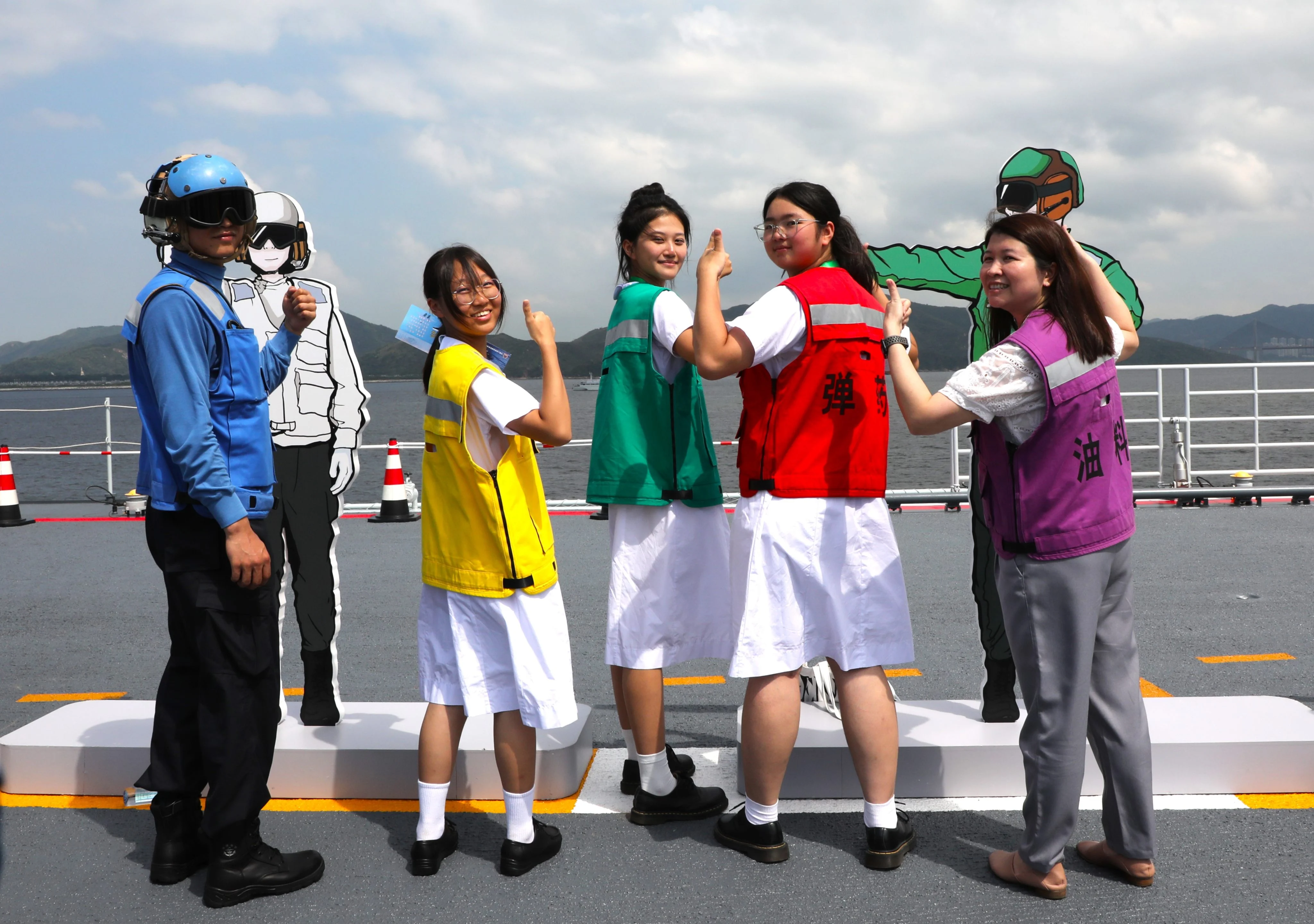By Enoch Wong
Crew members from the Chinese aircraft carrier Shandong have introduced the colourful roles of “deck rainbow-men” to more than 300 pupils at the PLA Stonecutters Island naval base in Hong Kong, prompting some to say a military career is inspiring.
On the second day of the PLA Navy’s Shandong carrier group’s visit to Hong Kong, seven crew members explained their roles to pupils, teachers and youth uniformed groups through a lively lecture on Friday.
To help coordinate hundreds of personnel on the carrier’s flight deck, crew members wear colour-coded vests – white, green, brown, purple, red, yellow and blue – each denoting a different role, “resembling a rainbow between sea and sky”.
Lieutenant Gao Xiang, a green rainbow-man responsible for guiding fighter jet launches, said: “This is my first time giving a defence lecture in Hong Kong, and it feels highly rewarding. Such interactions help young people absorb knowledge better, and I believe there will be plenty more opportunities in future.”
He said that, much like road traffic rules, a jet could only zip down the deck after the green rainbow-man gave the “carrier-style” take-off gesture – a dramatic crouched pose with an arm pointing forward – which went viral online in 2012 after China’s first successful launch of a J-15 fighter on its first aircraft carrier, the Liaoning.
Gao also pointed to the demanding teamwork required to ensure aircraft landed safely, noting that from the air the carrier deck could appear no larger than a postage stamp, especially in poor weather. The jets land at more than 200km/h but must stop in under three seconds by catching one of four arrester wires.
Yang Zhenyu, who wears a yellow waistcoat over a yellow long-sleeved shirt and directs deck traffic, joked that others had nicknamed him a “Minion” after the cartoon characters.
“But on the carrier, there is no room for messing around or repeated adjustments,” he said. “We are strict about parking aircraft safely and quickly in a space the size of two football pitches. Every minute saved increases our chances of victory.”
Form Two pupil Tam Bong-yik said he was most fascinated by missile loading on board, carried out by red rainbow-men.
“I feel very proud knowing our country is now so strong and can resist aggression,” Tam said, adding that he would be honoured to join the military if eligible. “In the past, the late Qing dynasty suffered foreign invasions, but today we no longer fear threats from abroad.”
Guo Yaodi, a member of the red rainbow-men responsible for ordnance support, elaborated: “An aircraft carrier’s combat effectiveness relies on its carrier-based aircraft, which depend on our missiles – air-to-air, air-to-ship and air-to-surface weapons.”
Secondary school student Chau Ka-ying said she was most impressed by the white rainbow-men, who provide medical support and safeguard crew health.
“Today’s experience opened my eyes to medical career options beyond ordinary hospitals and I feel inspired to explore more possibilities for my future,” she said.
“I am also inspired by the silent dedication of countless personnel behind this giant ship, safeguarding our national security and territorial integrity.
“I had read that an aircraft carrier is big, but I didn’t expect it to be as tall as a 20-storey building and 300 metres long.
Lin Junguang, a white rainbow-man, said the carrier had a hospital with 21 departments and remote consultation systems for complex procedures.
Sergeant Lin Huijing, who hosted the event, said the deck rainbow-men were just one part of the ship’s operations, with hundreds of other jobs among the Shandong’s 2,500 crew.
“And just as the carrier depends on its crew to generate combat power, our great nation needs every one of us to protect it.”
Blue, purple and brown rainbow-men also joined the lecture.
A blue rainbow-man described his role in maintaining aircraft systems and power supplies, and managing aircraft movements on deck.
A member of the purple rainbow-men explained their duties were to oversee aviation fuel and maintain nearly 10,000 metres of pipelines on the Shandong.
Brown rainbow-men maintain and repair aircraft. “If an aircraft fails, it cannot wait in the sky for repairs; it will crash,” one said. “That is why our maintenance standards are so demanding.”
The PLA Hong Kong Garrison, under the Southern Theatre Command, has had army, navy and air force units stationed in the city since the 1997 return to Chinese sovereignty. It manages 19 military sites, including 12 barracks.
Secondary pupils and teachers invited onto the Shandong on Friday unfurled a giant national flag on the deck and took photos in colour-coded identification vests.
Many expressed pride in being Chinese after the visit, describing military service as an honourable path. Some said that if the “one country, two systems” governing principle permitted it, they would join the armed forces to defend the nation.
One student said he had once dreamed of becoming a police officer to protect Hong Kong, but seeing the Shandong up close had inspired him to hope for a military career defending the motherland instead.
